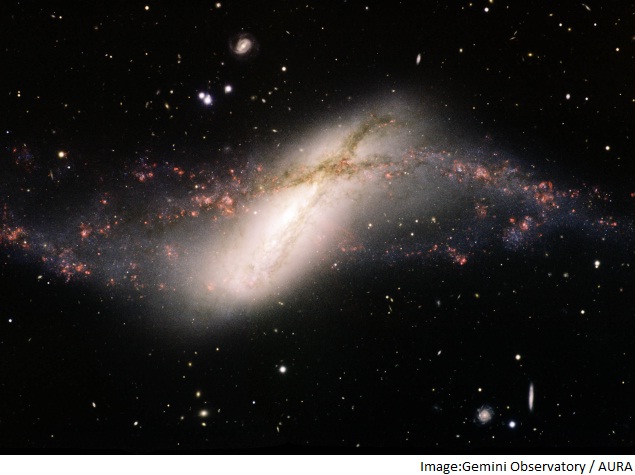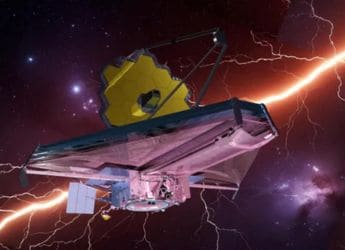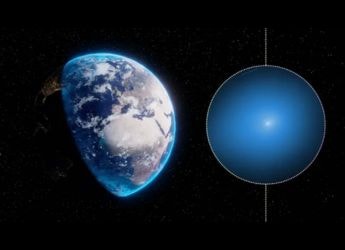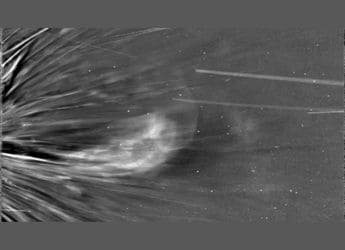- Home
- Science
- Science News
- Astronomers Observe Black Hole Having Breakfast in Bed
Astronomers Observe Black Hole Having Breakfast in Bed

The black hole at the centre of a galaxy 42 million light years away, in the constellation of Pisces, may have been dormant for millions of years, a team reported Thursday.
Scientists surveying the skies were lucky in 2012 to catch a flash of its awakening in a galaxy called NGC 660.
"The odds are pretty slim!" Megan Argo of the University of Manchester's Jodrell Bank Centre for Astrophysics told AFP.
"It is the first time we can watch it (a black hole awakening) happening in real time, so close to our own galaxy."
Black holes are very dense regions in spacetime with a gravitational force so strong that even light cannot escape.
They normally lurk dormant and undetected at the centre of galaxies, but can occasionally be tracked by their spectacular feeding frenzies - guzzling gas and dust, sometimes entire stars, and spitting out jets of debris.
In 2012, astronomers using a single radio telescope in Puerto Rico to monitor galaxies, noticed NGC 660 become hundreds of times brighter in just a few months - "a very unlikely and very unusual event," said Argo.
At first, it was not clear whether the burst was due to an exploding star, or the supermassive black hole.
So a team led by Argo trained radio telescopes in Britain, the Netherlands, Russia, China and South Africa on the galaxy, create a type of composite instrument with which to observe more detail.
They found a "very bright" object at the centre of NGC 660.
"Inactive black holes do not emit large mounts of radiation so we can only detect them by their gravitational effect on the orbits of stars around them. But the black hole in NGC 660 is now very obvious," said a Royal Astronomical Society (RAS) statement.
Argo said the black hole must have been activated when some material, most likely gas and dust, ventured too close to resist the gravitational pull, and fell in.
How long it remains active will depend on how much "food" there is.
"Studies of this nearby event will help in our understanding of how galaxies evolved over the lifetime of the Universe," added Argo.
The findings were presented Thursday at a meeting of the RAS National Astronomy Meeting in Llandudno, Wales.
Get your daily dose of tech news, reviews, and insights, in under 80 characters on Gadgets 360 Turbo. Connect with fellow tech lovers on our Forum. Follow us on X, Facebook, WhatsApp, Threads and Google News for instant updates. Catch all the action on our YouTube channel.
Related Stories
- Samsung Galaxy Unpacked 2025
- ChatGPT
- Redmi Note 14 Pro+
- iPhone 16
- Apple Vision Pro
- Oneplus 12
- OnePlus Nord CE 3 Lite 5G
- iPhone 13
- Xiaomi 14 Pro
- Oppo Find N3
- Tecno Spark Go (2023)
- Realme V30
- Best Phones Under 25000
- Samsung Galaxy S24 Series
- Cryptocurrency
- iQoo 12
- Samsung Galaxy S24 Ultra
- Giottus
- Samsung Galaxy Z Flip 5
- Apple 'Scary Fast'
- Housefull 5
- GoPro Hero 12 Black Review
- Invincible Season 2
- JioGlass
- HD Ready TV
- Laptop Under 50000
- Smartwatch Under 10000
- Latest Mobile Phones
- Compare Phones
- OnePlus 15R
- Realme Narzo 90x 5G
- Realme Narzo 90 5G
- Vivo S50 Pro Mini
- Vivo S50
- OPPO Reno 15c
- Redmi Note 15 5G
- Redmi Note 15 Pro 5G
- Asus ProArt P16
- MacBook Pro 14-inch (M5, 2025)
- OnePlus Pad Go 2
- Poco Pad M1
- Just Corseca Skywatch Pro
- Honor Watch X5
- Acerpure Nitro Z Series 100-inch QLED TV
- Samsung 43 Inch LED Ultra HD (4K) Smart TV (UA43UE81AFULXL)
- Asus ROG Ally
- Nintendo Switch Lite
- Haier 1.6 Ton 5 Star Inverter Split AC (HSU19G-MZAID5BN-INV)
- Haier 1.6 Ton 5 Star Inverter Split AC (HSU19G-MZAIM5BN-INV)

















